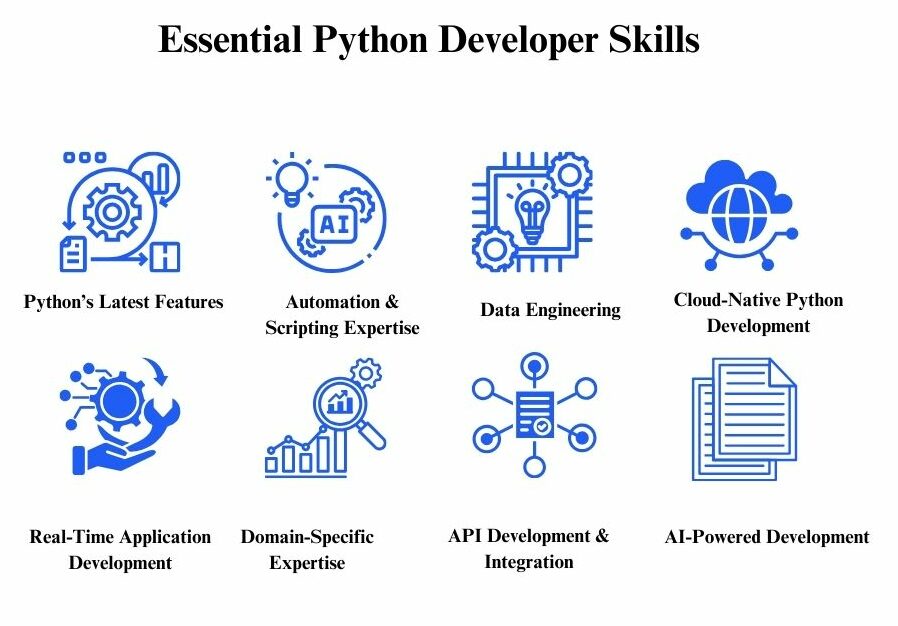How to Find Square Root in Python: Techniques Explained
Table of Contents

Python has become the go-to language for professionals across industries—be it data science, artificial intelligence, fintech, or software development. Among the many operations you’ll encounter while learning Python, calculating square root function in Python may appear simple, but it forms the foundation for advanced applications in statistics, algorithms, and machine learning. This blog will walk you through various ways to use the square root function in Python, helping you strengthen your coding basics while preparing for more complex challenges.
From Basics to Breakthroughs: How to Find Square Root in Python
Have you ever found yourself stuck while writing a program, unsure how to calculate something as simple as the square root function in Python? For many professionals transitioning into data science, analytics, or software development, even these small roadblocks can slow down their journey of upskilling. In today’s evolving job market, where coding proficiency is considered a critical skill across industries, understanding the fundamentals is as important as mastering advanced algorithms.
Python, one of the most in-demand programming languages, powers everything from artificial intelligence to fintech applications. Among its many applications, learning the square root function in Python may seem like a small step, but it’s a building block for solving larger computational problems. Whether you’re working on financial models, engineering simulations, or data-driven research, knowing how to find square root function in Python is a foundational skill that sets you up for bigger challenges.
In this blog, we’ll explore multiple techniques to calculate square root function in Python, break down their use cases, and show you why mastering these basics matters for your career growth.
Techniques to Find Square Root Function in Python
Below, we’ll cover the most commonly used methods to calculate square root function in Python in a clear, listicle format. Each technique will include an explanation, a code snippet, and a real-world connection.
1. Using the Exponentiation Operator (**)
Python allows you to raise numbers to fractional powers. Since the square root of a number is equivalent to raising it to the power of 0.5, this is one of the simplest ways to implement a square root function in Python.
# Square root using exponentiation
number = 16
square_root = number ** 0.5
print(square_root)
# Output: 4.0
Pros:
- No need for external libraries.
- Easy to use and remember.
Cons:
- Limited readability for beginners.
- May lead to floating-point precision issues in complex cases.
2. Using the math Module
The built-in math module provides the sqrt() function, which is precise and highly readable.
import math
number = 25
square_root = math.sqrt(number)
print(square_root)
# Output: 5.0
Here, the sqrt function in Python is optimized for accuracy.
Pros:
- Clean syntax.
- Well-suited for real-world applications where accuracy is essential.
Cons:
- Requires importing the math module.
3. Using the cmath Module (for Complex Numbers)
What happens if you try to calculate the square root of a negative number? The math.sqrt() function will throw an error. To handle such cases, Python’s cmath module comes into play.
import cmath
number = -9
square_root = cmath.sqrt(number)
print(square_root)
# Output: 3
Real-World Use: Electrical engineering and signal processing often require complex numbers, making this method critical.
4. Creating a Custom Function
For practice and deeper understanding, you can write a custom square root program in Python using iterative methods like the Newton-Raphson method.
def newton_sqrt(n, tolerance=1e-10):
guess = n / 2
while abs(guess * guess – n) > tolerance:
guess = (guess + n / guess) / 2
return guess
print(newton_sqrt(49))
# Output: 7.0
Why It Matters: Writing custom logic helps professionals strengthen their problem-solving skills and prepares them for algorithmic challenges in coding interviews.
5. Using NumPy’s sqrt()
For professionals working in data science or machine learning, NumPy is an indispensable library. It provides a vectorized implementation of the square root function in Python, allowing square root calculations across arrays and datasets.
import numpy as np
arr = np.array([4, 9, 16, 25])
square_roots = np.sqrt(arr)
print(square_roots)
# Output: [2. 3. 4. 5.]
Real-World Use: Perfect for processing large datasets, matrix operations, and AI applications.
Comparison of Techniques
By looking at this comparison, you can quickly decide which method of using the square root function in Python best fits your project. Whether you’re writing quick scripts, working with complex numbers, or handling large datasets, Python offers flexible solutions for every need.
| Method | Best Use Case | Library Required | Handles Complex Numbers |
|---|---|---|---|
| Exponentiation (**) | Quick, small scripts | No | No |
| math.sqrt() | General-purpose, accurate square root function | Yes (math) | No |
| cmath.sqrt() | Complex number calculations | Yes (cmath) | Yes |
| Custom Function | Algorithm learning, coding practice | No | Customizable |
| NumPy sqrt() | Data science, large datasets | Yes (numpy) | No (use np.lib.scimath.sqrt for complex) |

*zydesoft.com
Industry Relevance of Python Skills
The ability to write even a basic square root program in Python contributes to larger competencies in programming and computational thinking. According to the World Economic Forum’s Future of Jobs Report 2023, Python ranks among the top five most in-demand programming languages for roles in data science, AI, and software development.
Here’s an overview of how Python proficiency, including basic problem-solving techniques, translates into career opportunities:
| Industry | Common Roles | Average Salary in India (per annum)* |
|---|---|---|
| Data Science | Data Analyst, Data Scientist | ₹6 – ₹14 lakhs |
| Software Development | Python Developer, Backend Dev | ₹5 – ₹12 lakhs |
| AI & Machine Learning | ML Engineer, AI Specialist | ₹7 – ₹18 lakhs |
| Finance & Fintech | Quant Analyst, Risk Modeler | ₹6 – ₹15 lakhs |
How Jaro Helps
Mastering concepts like how to find sqrt function in Python is only the beginning. To truly thrive in a competitive job market, professionals need structured learning, expert guidance, and access to world-class programs. This is where Jaro Education plays a pivotal role.
About Jaro Education’s Collaborations
Jaro partners with leading universities and institutes such as IIMs, IITs, and international universities to deliver career-enhancing online and executive programs. These collaborations provide learners with the credibility of premier institutions combined with the flexibility of online formats.
Why Choose Jaro?
- Personalized Counseling: Understand your career goals and get expert advice on choosing the right program.
- Exclusive Programs: Access IIT- and IIM-certified courses designed for professionals seeking industry relevance.
- Flexible Learning: Online, live, or blended formats tailored for working professionals.
- Value-Added Services: Through Jaro Connect, learners gain networking opportunities and additional career support.
Program Highlights
Online MBA – Dr. D. Y. Patil Vidyapeeth
- Duration: 2 Years
- Learning Format: Online
- Key Skills Covered: Data analysis, Python programming, AI & ML fundamentals, leadership, and management.
- Ideal Learners: Working professionals, mid-career managers, and graduates looking to transition into tech-driven roles.
Note: Jaro Education acts as a service partner, not the degree-granting body. For certification programs, Jaro exclusively collaborates with institutes like IIMs and IITs.
Start your learning journey today. Get personalized guidance from our experts and explore exclusive programs with India’s top institutes.
Turning Basics into Career-Building Skills
Learning how to find square root function in Python is more than just understanding a mathematical operation—it’s about building a mindset of problem-solving. In a fast-changing digital economy, small skills compound into larger competencies that define career success.
As you reflect on your professional growth, remember that the right blend of technical skills and structured education can unlock new opportunities. Jaro Education ensures you’re not navigating this journey alone but with the mentorship, resources, and industry insights you need to succeed.
Take the next step today—explore Jaro’s programs and open doors to future-ready careers.
Frequently Asked Questions
What kind of support does Jaro provide during the course?
Jaro offers personalized counseling, mentorship, and access to Jaro Connect for networking. While academic delivery is managed by the partnered institute, Jaro ensures learners receive complete guidance throughout.
Can I apply if I am working full-time?
Yes, most programs are designed with flexibility, featuring online or weekend sessions that accommodate working professionals.
How is this program different from a regular online course?
Unlike generic online courses, Jaro’s programs are curated in collaboration with premier institutes such as IIMs and IITs, ensuring academic rigor and industry relevance.
Will this program help me transition into a new industry?
While no program can guarantee a career shift, Jaro’s offerings equip learners with in-demand skills, industry insights, and networking opportunities that enhance career mobility.
Is prior coding experience necessary for Python-related programs?
Not always. Many programs cater to beginners, starting with fundamentals like the square root function in Python, before advancing to complex applications in AI and data science.
Do I need to have a technical background to enroll in these programs?
Not necessarily. Many Jaro-partnered programs are designed for professionals from diverse fields. With structured learning modules, expert faculty, and foundational coverage of key topics like Python basics — how to find square root function in Python, even learners without prior technical experience can build confidence and progress toward advanced concepts.
Recent Blogs
It seems we can't find what you're looking for.













